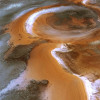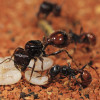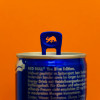Quiz: Do longer fingers have faster-growing nails?
Interview with
The panel are put through their paces with a fiendish quiz, with David Rothery and Gareth Corbett going head to head with Sarah Madden and special guest Vinnie Ferrara.
Chris - This week, our quiz will be split into 3 rounds, and you can confer. We’re going to have two teams. We’re going to have Gareth and David. Team 2 is going to be Sarah, and because we unfortunately had one person short this week Sarah, we’ve found you somebody. Vinnie has kindly agreed to pop in and Vinnie’s going to be your sidekick.
How your science Vinnie, is it good?
Vinnie - I’m sorry. I’m not going to do very well for you here Sarah.
Chris - Moral support probably.
Sarah - No, I’m very grateful.
Chris - You’re a big enough brain Sarah, I’m sure you’re going cope adequately well.
TEAM 1 - Chris - What number is opposite the 3 on a dice?
David - It always adds to 7 we think so we’re agreed it’s 4.
Chris - Well they’re off to a good start it’s indeed 4. Opposite sides always add up to 7.
TEAM 2 - Chris - If a bat and a ball together cost £1.10 and the bat costs £1 more than the ball, how much does the ball cost?
Vinnie - £1.10. If it costs 10p and it’s £1.00 more.
Sarah - The bat costs £1.00 more than the ...ahhh.
Vinnie - Yeah.
Sarah - I can do this.
Vinnie - I’ll let you take the flack.
Chris - that’s very gentlemanly of you Vinnie.
Sarah - Sorry, this is so stupid. We can just sacrifice it - I’m sorry. I know it’s really easy. My simultaneous equations are just going out the..
Chris - It’s actually a trick question because of course it’s 5p because you add £1 to get £1.05 for the bat and the total is £1.10.
I fell for it too Sarah. When I first heard that a few years ago the gut reaction you immediately get it wrong.
So we’ve got David and Gareth out in the lead at the moment. Back to you...
TEAM 1 - Chris - The 2017 Nobel Prizes are in the news at the moment and with that in mind I would like to know what the Swedish scientist Alfred Nobel, after whom the prize is named, is famously credited with inventing?
David - It was dynamite wasn’t it? I was worried you were going to ask me who’d won the prizes this year and that would have show us up awfully. But I think he invented dynamite - some explosive.
Gareth - I’m happy to go with you.
David - What was he famous for is the question?
Chris - Yeah.
David - For inventing dynamite.
Chris - You’re on fire - a bit like his dynamite. It was indeed dynamite - Nobel invented it in 1867 and originally sold dynamite as "Nobel's Blasting Powder" but decided to change the name to dynamite, from the Ancient Greek word dunamis - power or strength. So they knew all about branding even in Nobel’s day.
So two points so far to David and Gareth.
Right. Let’s see if you can salvage your reputation a little bit you two.
Sarah - I know. ‘I'm just so annoyed with myself but it’s fine.
TEAM 2 - Chris - In 1901 a group of divers discovered what is believed to be an ancient analogue computer made from an intricate combination of gears. It could predict eclipses. What was it called?
Vinnie - I have no idea.
Chris - Do you want to have a guess. Is David helping you?
Sarah - Yeah, he’s cheating. I don’t know it so I can pretend to play it cool.
Chris - Hang on a minute.
Sarah - I can’t read his handwriting.
Chris - David, what have you written?
David - I’ve written antikythera mechanism.
Chris - The device is called the antikythera so plus one to this team for the correct answer and minus one to the other team for cheating and helping. So now the scores are even.Now we have an interesting position because everyone is on the same score. So we’re into the final round - everything to play for. I’m so glad you cheated David and enabled me to dock you a point.
Bit of detail about the antikythera, it dates from the time between 205BC to 70BC; experts think it may have been designed by Hipparchus who is considered the founder of trigonomics since it uses his theory to track the motion of the moon. So it was an ancient time-keeping and celestial prediction computer.
TEAM 1 - Chris - True or false, the Mongolian Pepper Mouse is a small rodent that lives in central Asia known for a defensive ability to spray its saliva which contain capsaicinoids - the chemical that makes chillies pungently hot and burning. What do you think?
Gareth - It sounds like the sort of thing that would be true to me.
David - It’s probably a trick question. It’s not in it’s saliva. Go for it.
Gareth - We’ll say true because it sounds plausible.
Chris - We completely made that one up actually. There is no such thing as a Mongolian Pepper mouse. But we did cover on this programme back in 2006, the discovery by David Julius from the University of California, San Francisco, the discovery of the component of a venom of a certain tarantula that does activates the very same receptors as capsaicin which you find in chillies, so when you get bitten by the spider it burns in the same way as if you’d rubbed chilli peppers on your wound.
So, no points to you so far. Let’s see if you’re going to end the day level pegging or if the other team can snap victory from the jaws of near defeat.
TEAM 2 - Chris -In humans, the longer your fingers, the faster your nails grow? Is that fact or fiction.
Vinnie - That doesn’t seem like something that should be right.
Sarah - No. So if your fingers are longer I think it will be further from your - I mean it’s a greater distance so they’ll grow slower.
Chris - You’re going for slower. So you think it’s the wrong way round.
Sarah - I think…
Chris - So you think it’s wrong.
Sarah - Yeah.
Vinnie - Yeah.
Chris - No actually it’s true - That is true. In mammals, the rates of nail growth are proportional to the length of the terminal phalanx of the digit, that means the end bit of your finger beyond the last joint and so your index fingernail grows slightly faster than your small fingernail. And your fingernails grow about four times faster than your toesnails. And your nails’ average rate of growth is about 3mm per month.
Which Geologist David would know is roughly the same rate at which the continental plates of Eurasia and America are moving apart because of seafloor spreading.
David - It also explains why I don’t have to cut my toenails as often as I have to cut my fingernails.
Chris - That’s right, yeah.
David - I’ve been observing this as a phenomenon thing and surely I’ve got to cut my toenails as well?
Chris - Ever the scientist.
David - Now I realise I don’t have to and I understand why now. It’s brilliant.
Chris - I’m glad we educated you.
Thank you and that also means that no-one goes home the winner. Everyone’s even stevens so that’s wonderful.
Thank you very much and thank you Vinnie for stepping in so well.
Vinnie - You’re welcome. I treasure myself on knowing absolutely nothing.
Chris - Well, at least we had an even balanced team,didn’t we?










Comments
Add a comment